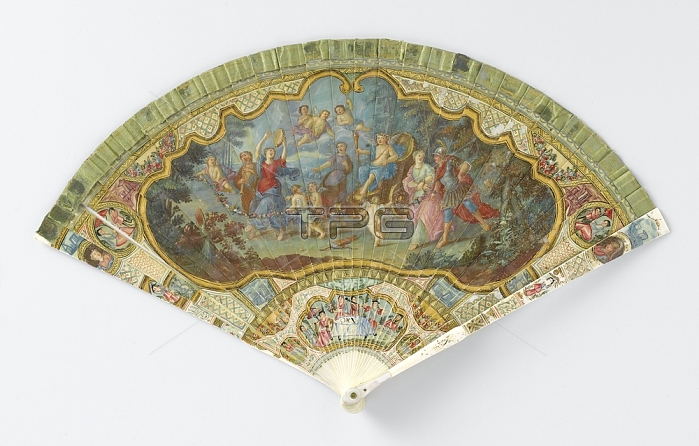
Bris?range of ivory; entirely painted with tempera over which a lacquer-like varnish; with a central cartouche in which 'the Triumph of Love' on the front and an Arcadian seascape at the back; surrounded by chinoiseries; whole painted with tempera over which a lacquer-like varnish; with a central cartouche in which 'the Triumph of Love' in the front and an Arcadian seascape at the back. Front: although the waiaer consists of a whole; the painted decoration attempts to create the illusion that the fan consists of a leaf and a frame. The loose legs are connected with a ribbon at the top. The Triumph of Eros; Eros sits on a triumphal cart; preceded by musicians and erots. To the right of this group are two lovers; most likely Mars and Venus. The allegorical representation goes back to Petrarch's 'Trionfi' from 1352; in which he was one of the first to personify abstract ideas and placed them in triumph on a victory cart. Grid work and chinoiseries around the cartouche. Back: an Arcadian seascape. Grid work and chinoiseries around the cartouche. Antique portraits are painted on the outer legs on both sides above. After the founding of the Dutch East India Company in 1602; a limited supply of painted objects from China and Japan to Europe started. Around the middle of the 17th century the demand for this scarce and therefore highly desirable lacquerware had risen to such an extent that people in England and the Republic began to imitate the Eastern example. Even before the 'Vernis Martin' was patented in 1730; attempts were made to imitate it.; anonymous; France (possibly); c. 1700 - c. 1750; geheel; verf; vernis; rand sluitpin; sluitpin; lint; cutting; s 36 cm x l 21.2 cm
| px | px | dpi | = | cm | x | cm | = | MB |
Details
Creative#:
TOP28310936
Source:
達志影像
Authorization Type:
RM
Release Information:
須由TPG 完整授權
Model Release:
No
Property Release:
No
Right to Privacy:
No
Same folder images:

 Loading
Loading